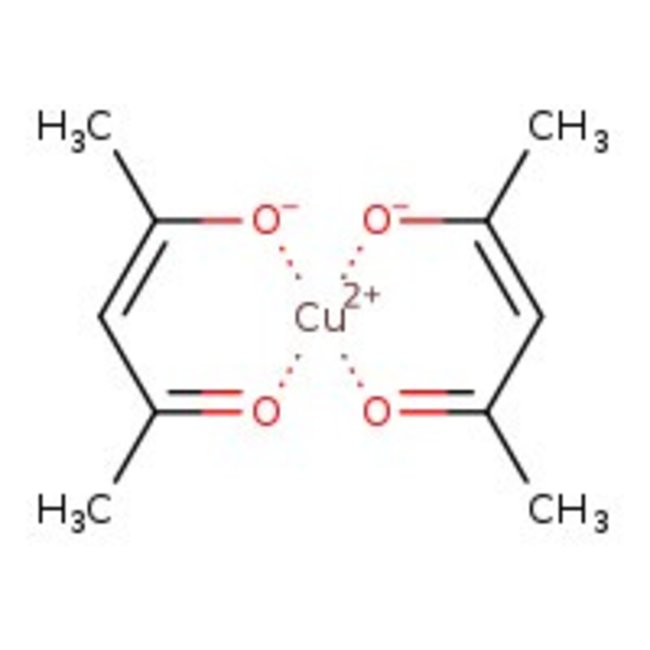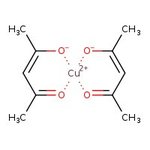Search Thermo Fisher Scientific
Thermo Scientific Chemicals
Copper(II) 2,4-pentanedionate, 98%
CAS: 13395-16-9 | C10H14CuO4 | 261.76 g/mol
| Catalog Number | Quantity |
|---|---|
| FSKA14920.18 | 50 g |
Catalog number FSKA14920.18
View Price:Sign InSign in to see your account pricing. Need an account? Register with us today.
Quantity:
50 g
Specifications
Chemical Name or MaterialCopper(II) 2,4-pentanedionate
CAS13395-16-9
Health Hazard 1H302+H312+H332-H315-H319-H335-H360-H500
Health Hazard 2GHS H Statement
H315-H319-H335
Causes skin irritation.
Causes serious eye irritation.
May cause respiratory irritation.
H315-H319-H335
Causes skin irritation.
Causes serious eye irritation.
May cause respiratory irritation.
Health Hazard 3P201-P202-P261-P264b-P270-P271-P280i-P281-P301+P312-P302+P352-P304+P340-P305+P351+P338-P308+P313-P312-P330-P332+P313-P362-P501c
View more
Copper(II) 2,4-pentanedionate is used as a catalyst for carbene transfer reactions, coupling reactions and Michael addition reactions. It is also used as a catalyst for the polymerization of olefins and transesterification reactions as well as a PVC stabilizer. Further, it is used as a curing agent for epoxy resins, acrylic adhesives, silicone rubbers. In addition to this, it is used as a lubricant additive and paint drier.
This Thermo Scientific Chemicals brand product was originally part of the Alfa Aesar product portfolio. Some documentation and label information may refer to the legacy brand. The original Alfa Aesar product / item code or SKU reference has not changed as a part of the brand transition to Thermo Scientific Chemicals.
Applications
Copper(II) 2,4-pentanedionate is used as a catalyst for carbene transfer reactions, coupling reactions and Michael addition reactions. It is also used as a catalyst for the polymerization of olefins and transesterification reactions as well as a PVC stabilizer. Further, it is used as a curing agent for epoxy resins, acrylic adhesives, silicone rubbers. In addition to this, it is used as a lubricant additive and paint drier.
Solubility
Insoluble in water.
Notes
Incompatible with strong oxidizing agents.
Copper(II) 2,4-pentanedionate is used as a catalyst for carbene transfer reactions, coupling reactions and Michael addition reactions. It is also used as a catalyst for the polymerization of olefins and transesterification reactions as well as a PVC stabilizer. Further, it is used as a curing agent for epoxy resins, acrylic adhesives, silicone rubbers. In addition to this, it is used as a lubricant additive and paint drier.
Solubility
Insoluble in water.
Notes
Incompatible with strong oxidizing agents.
RUO – Research Use Only
General References:
- The most effective of a number of metal chelates studied in enabling the reduction of aromatic nitro-compounds by sodium borohydride: J. Chem. Soc., Perkin 1, 2409 (1979).
- Promotes the coupling of organozinc reagents with allylic halides to give , δ-unsaturated esters: Tetrahedron Lett., 24, 2749 (1983).
- Catalyst for the carbenoid reaction of diazoacetate esters with silyl enol ethers to give siloxycyclopropanes: Liebigs Ann. Chem., 512 (1984); Org. Synth. Coll., 9, 573 (1998).
- In catalytic amounts promotes the selective O-benzylation of primary alcohols with benzyl chloride, in the presence of secondary alcohols or phenols: Tetrahedron Lett., 44, 8483 (2003). For a brief feature on uses of the reagent in synthesis, see: Synlett, 2859 (2005).
- Jia, Y.; Su, J.; Chen, Z.; Tan, K.; Chen, Q.; Cao, Z.; Jiang, Y.; Xie, Z.; Zheng, L. Composition-tunable synthesis of Pt-Cu octahedral alloy nanocrystals from PtCu to PtCu3 via underpotential-deposition-like process and their electro-catalytic properties. RSC Adv. 2015, 5 (23), 18153-18158.
- Staniuk, M.; Zindel, D.; van Beek, W.; Hirsch, O.; Kränzlin, N.; Niederberger, M.; Koziej, D. Matching the organic and inorganic counterparts during nucleation and growth of copper-based nanoparticles - in situ spectroscopic studies. CrystEngComm 2015, 17, 6962-6971.



